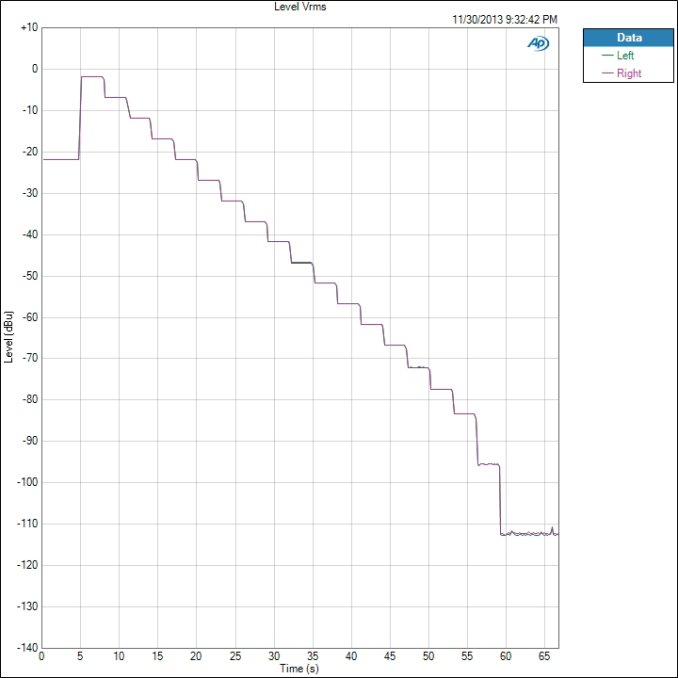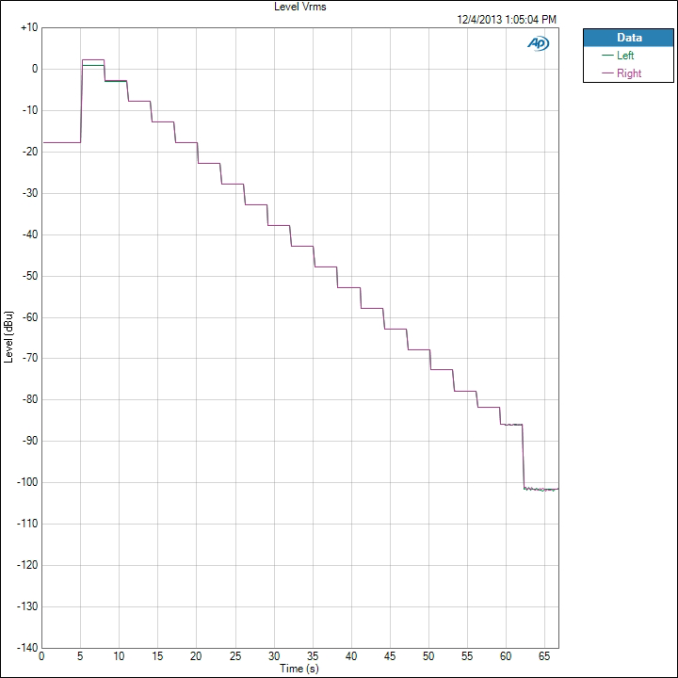Smartphone Audio Quality Testing
by Chris Heinonen on December 8, 2013 5:15 PM EST- Posted in
- Smartphones
- Audio
- Mobile
- Tablets
- Testing
Dynamic Range
The dynamic range of the phone indicates the difference between the loudest possible sound and the background noise. The more residual noise in the background, the lower the dynamic range. Phones with more powerful amplifier sections will typically produce a greater dynamic range. The residual noise level is often constant, so as the overall volume level increases the difference between the music and the noise increases as well.
The best performer here is the iPhone 5 again, with 92.214 dB of range. The worst is the Nexus 5 with only 89.332 dB. A difference of 3 dB is not something I would concern myself over. If we see a phone or tablet that drops down below 80 dB then I will start to show more concern.
Crosstalk
Crosstalk, like dynamic range, is just a number here. This is the measurement how much signal leaks from one channel into another. If an instrument should only be in the right ear, some of that signal will leak into the left ear, but we want that as low as possible. The results are expressed in -dB, or how much quieter one ear is than the intended ear.
On the Note 3 we see a wonderful crosstalk measurement of -117.2 dB so the sounds in one ear are -117 dB quieter in the other ear. This makes them impossible to hear. The worst is the iPhone 5, with only -75.624 dB of isolation.
Stepped Response
The stepped response uses a 1 kHz 0 dBFS tone but measures output level from maximum volume to minimum volume. We can see how large the volume steps are and how many there are. It doesn’t produce a number we can use, but it ties back into our other results. For a good example, we can look at the Note 3.
We see steps that are around -5 dBu each. The final level is muted and just the background noise of the device. Each step is clean and even but as we get lower and lower we see noise start to intrude. This is the background noise starting to become audible in the signal. The flatter the levels are, the quieter it will be. Now, let us look at the Nexus 5.
Notice at the very top how the right and left channels do not overlap. That is the clipping we talked about at the very beginning. It isn’t until the 4th volume setting that the level difference is down to nothing. Because of this, I would consider the top 3 volume settings of the Nexus 5 as ones that should be avoided. They each have enough THD+N introduced into them that it will sound poor, and one ear will be louder than the other.












188 Comments
View All Comments
Origin64 - Monday, December 9, 2013 - link
"Here we see that Beats is adding a +3.5 dB boost from 60 Hz to 90 Hz, but the deviation from 0 dB goes from 30Hz to 300 Hz. Past 6.5 kHz we also see a rise in the treble."And people pay 300 bucks for a headphone that does exactly, and only, this. Its a good joke, really.
willis936 - Monday, December 9, 2013 - link
To Chris:Check out NwAvGuy's blog if you haven't already. He appeared and disappeared a few years ago bringing with him a headphone amp design and (more importantly) a breath of fresh, objective air in testing audiophile headphone equipment. He has some good data there and comparing testing methodologies might be insightful for things to try here on anandtech.
cheinonen - Monday, December 9, 2013 - link
I've read his full blog and wish it was still updated.Impulses - Monday, December 9, 2013 - link
Tyll's Inner Fidelity blog is another great resource.adityanag - Monday, December 9, 2013 - link
This is excellent. Also the reason why I've been reading Anandtech since 1998. Keep up the great work, guys.Gadgety - Monday, December 9, 2013 - link
I appreciate this article, Chris. An improvement would be a summary table of all the models compared on one page, and some sort of analysis beyond the "poor performance" comparison. I've also seen data that the specs will change significantly for worse when headphones are attached to the phones.xodusgenesis - Monday, December 9, 2013 - link
Finally some in-depth audio anlysis. I've been waiting for this as I actually use my smartphone as a phone (I know shocker in today's age) and media player most of the time.ZoSo - Monday, December 9, 2013 - link
Would like to see some results of a few current WP8 phones, Nokia in particular.asgallant - Monday, December 9, 2013 - link
Awesome! I have been wanting to see some audio analysis done for a while now. Is there any chance of extending this to test audio on motherboards, sound cards, and laptops as well?lever_age - Monday, December 9, 2013 - link
Glad to see this. My suggestions are as follows:1. Include an output impedance measurement. If you're using these as decent-quality audio players with headphones, this is one of the most important things to know for certain headphones, at least. Who cares what the measured frequency response with a resistor is if your source's output impedance is causing +/- 5 dB swings in response for some balanced armature IEMs?
2. Standardize THD+N tests to a given output level for all phones (say 0.1 V or whatever else; the danger is picking something standard like 0 dBu that some phones could possibly not even reach). Don't just use whatever the max volume is, especially since that's into clipping territory for some phones. People don't scale their playback levels by how much power the electronics is capable of handling. I hope. Referencing a fixed level is more fair.
3. Please do keep reporting which phones run into clipping (and at what load) at volume settings at max or less. Also what some nonstandard settings like Beats Mode do.
4. Make careful distinction of THD with headphones as load and as not. If not loading with headphones-level impedance that is mostly testing the performance when hooked up to say a speaker system with a patch cable, which I don't think many people are doing these days.
5. When reporting maximum level, standardize to point of say 1% THD (or max volume, whichever comes first). Also note if headphones are used or not. It'd be meaningless to quote maximum levels far past the point of clipping.
6. If you have time, see if you can coax and measure some bad behavior out of the phone by using Wi-Fi, Bluetooth, LTE, etc. simultaneously, maybe some CPU/GPU load and seeing if that causes audio issues. Honestly, glitchy or cackling playback are far greater issues to audio quality than looking at 0.3 vs. 1 dB dips in frequency response at 19 kHz or something like that. Or output power levels most people don't need.